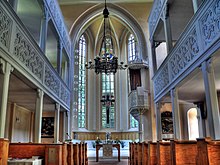Sonnefeld Monastery

The monastery Sonnenfeld is a former monastery of Cistercian nuns in Sonnefeld in Bavaria . The monastery church is today an Evangelical Lutheran parish church.
history
founding
The monastery consecrated to the Blessed Virgin Mary was founded in 1260 by Heinrich II. Von Sonneberg and his wife Kunigunde. The abbey was initially located in Ebersdorf and was relocated to Hofstädten after a fire around 1287. Hofstädten only took on the name of the monastery or office as Sonnefeld in 1889. At the beginning, the landlord was the Bamberg bishop Berthold von Leiningen , who tried to prevent the Count of Henneberg from advancing by founding the monastery . The spiritual head was the Bishop of Würzburg . The settlement took place from the Maidbronn monastery . The facilities included the villages of Frohnlach and Ebersdorf . In 1262 the abbots of Ebrach and Bildhausen inspected the progress and ensured that the order was recognized.
Further development
In 1279, the founder of the monastery, Heinrich II, was among the witnesses when the Himmelkron monastery was founded . The order of the abbesses is shown in the list of abbesses of Sonnefeld . The Sonnefeld monastery became Hennebergish. It flourished under the Abbess Anna von Henneberg , whose epitaph has been preserved. The decline took place in the 14th century. The number of nuns had risen beyond the economic base and had to be limited to 50 people. The care for unmarried people and widows of nobles and commoners was increasingly the focus of monastic life. Contrary to the rules of the order, private property had become common, but the number of conversations fell . Under the abbess Margaretha von Brandenstein (around 1460–1503) the monastery flourished for the last time, because the abbess managed to discharge her debt and she implemented several building projects. In 1504 the majority of the nuns turned against the abbess when she wanted to reinstate the cloister , the abbot of the Georgenthal monastery was appointed as a visitor and imprisoned some of the nuns.
Possessions
Based on the former Bamberg fiefdoms of Sonnefeld, Frohnlach and Ebersdorf, the monastery increased its property with further goods from Bamberg , the Banz monastery and the Saalfeld Benedictine abbey . A papal letter of protection from 1291 names 34 villages and the monastery developed into one of the largest landowners in the Coburg region by the end of the Middle Ages. The inheritance book of 1514 lists 77 localities in which the monastery had properties. An almost closed domain existed around Sonnefeld. There were also foundations from local aristocratic families, especially the von Schaumberg family and the von Kunstadt marshals . Since 1331 the monastery had a right of residence in a Bamberg town house on the Green Market and was the owner of several houses in Coburg. Through Anna von Henneberg, the monastery came into the possession of vineyards in Nüdlingen and Nassach .
End of the monastery
In 1524 the nuns pushed through a Lutheran preacher against the will of the last abbess Margaretha von Zedtwitz . When the abbess died a year later, the councilors of the Saxon elector Johann appointed an administrator for the monastery property. Five of the 14 nuns left the monastery in favor of a secular life, the last remaining nun died in 1572. The property fell to the Coburg rulership as an office. Anna of Saxony spent several years of her captivity in the former monastery and was buried in the monastery church.
Church and monastery building
The church was built according to the style of the Cistercian women next to the choir and nave with an adjoining ground-level crypt, above which the nuns' gallery . The choir is a work by Heinrich Parler . This character was partially lost due to fires and renovations. Among other things, the typical roof turret was removed. Only a few tombs have survived from the time of the monastery; they recall the abbess Anna von Henneberg and the Schaumberger knights. The monastery church became a Protestant parish church in 1540. The previous local church is today's cemetery church.
In 1634 the church and monastery burned down. In 1856 the facility was restored. Only part of the east wing of the monastery has been preserved. A keystone in the vault of the chapter house bears the coat of arms of the abbess Dorothea von Kemmaten (around 1453). Remains of paintings from the 2nd half of the 15th century can still be seen.
The monastery complex consisted of several buildings, which were surrounded by a moat. In addition to residential buildings, the buildings were mainly used for agriculture and administration. A monastery mill was operated. The buildings also included an office building, a labor festival and a school.
literature
- Harald Bachmann: Sonnefeld - past and present . Sun field.
- Joachim Hotz: Cistercian monasteries in Upper Franconia . In: Great Art Guides . tape 98 . Schnell and Steiner, Munich, Zurich 1982, ISBN 3-7954-0842-3 , pp. 64-70 .
- Walter Lorenz: Campus Solis. History and property of the former Cistercian abbey of Sonnefeld near Coburg . Kallmünz, Kallmünz 1955.
- Hans Roser: Monasteries in Franconia . Eulen Verlag, Freiburg 1988, ISBN 3-89102-108-9 , pp. 224 f .
- Hermann Wank: market and monastery Sonnefeld . Coburg 1925.
Web links
- Sonnefeld Monastery , basic data and history: Zisterze Sonnefeld - hope for eternal intercession in the database of monasteries in Bavaria in the House of Bavarian History
Individual evidence
- ↑ Christine Riedl-Valder: Cisterze Sonnefeld? Hope for eternal intercession
- ^ Walter Lorenz: Campus Solis. History and property of the former Cistercian abbey of Sonnefeld near Coburg . Verlag Kallmünz, 1955, p. 159
Coordinates: 50 ° 13 ′ 18 ″ N , 11 ° 8 ′ 3 ″ E



